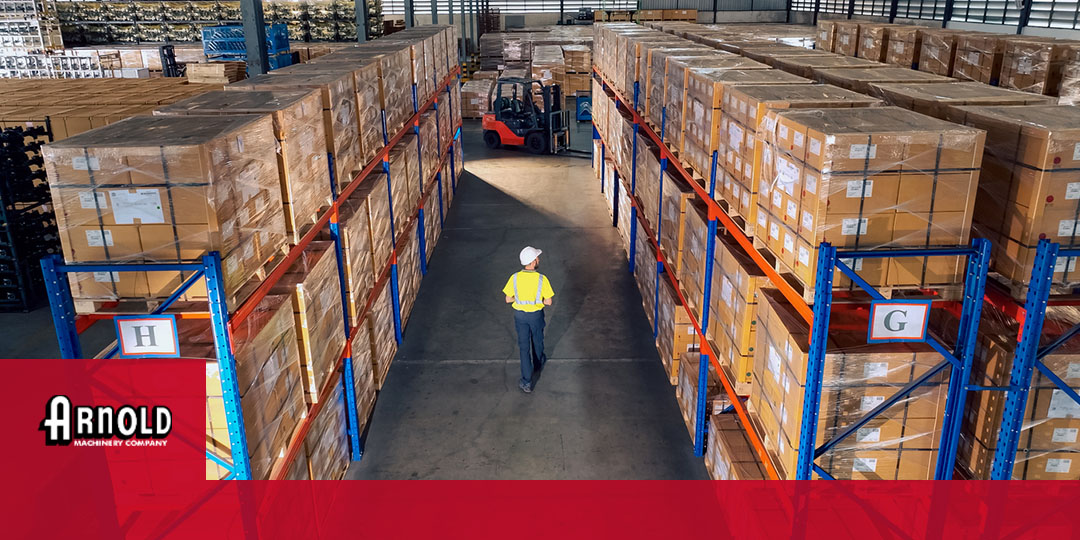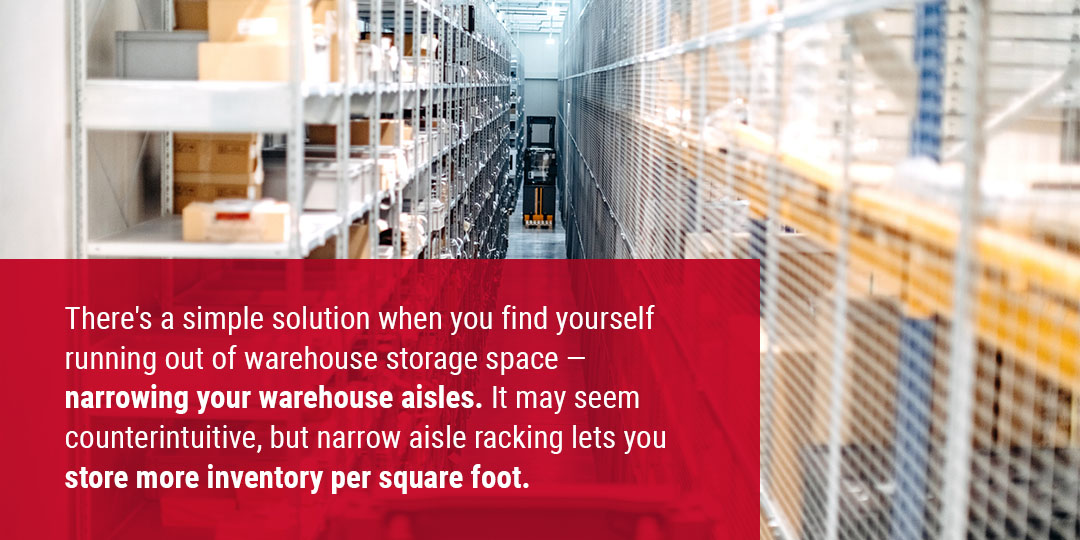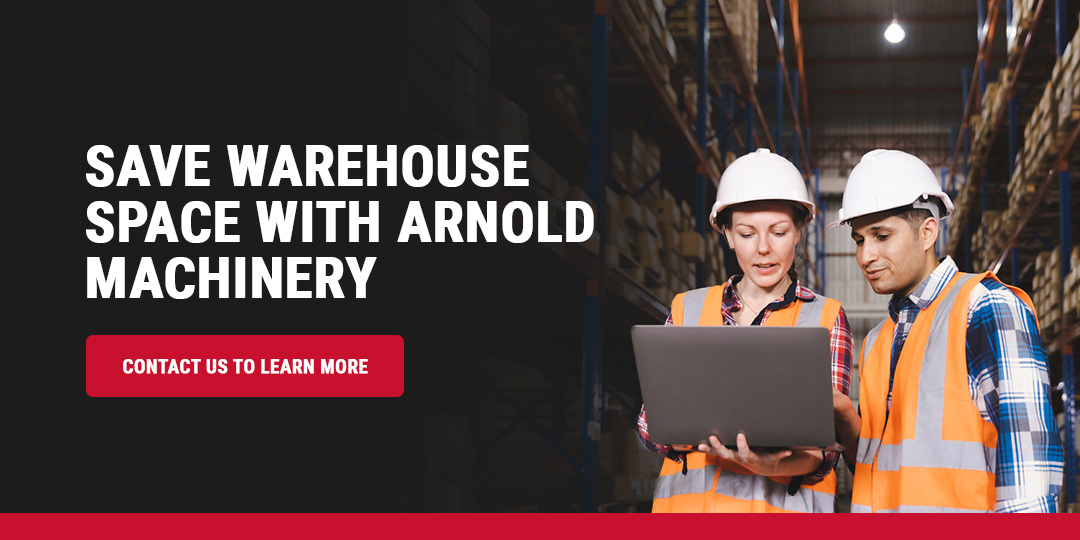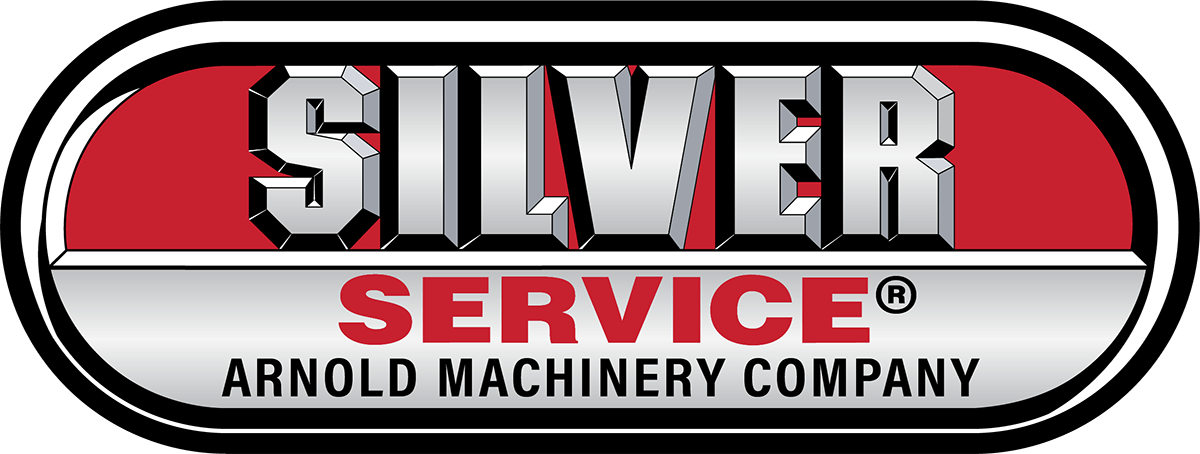How to Save Warehouse Space
Blogs
You don’t have to renovate your entire facility or break the bank to create more warehouse space. Even simple adjustments to your existing layout and equipment can make a world of difference in increasing your storage capacity.
Whether narrowing your warehouse aisles, installing a mezzanine platform or investing in equipment that better accommodates your layout, there are numerous space-saving strategies to consider. Read on to explore some practical warehouse space utilization tips.
The Benefits of Optimizing Your Warehouse Space
A well-organized warehouse can help you overcome challenges like:
- Clutter and waste.
- Ineffective inventory management.
- High labor costs.
- Unpreparedness for seasonal demands.
- Slow order processing.
Optimizing your facility’s layout can increase productivity and efficiency, which can impact profits and customer satisfaction. Here are some benefits of leveraging your warehouse space.
1. More Storage Space
Making the most of your warehouse layout enhances your facility’s storage capacity. Finding untapped opportunities to boost storage — such as installing a mezzanine platform system, opting for vertical racking or reducing your aisle width — is a great way to free up space and cut down on extra storage costs.
2. Improved Productivity
An optimized warehouse layout creates a smoother traffic flow of inventory, staff and equipment, significantly boosting productivity. You can streamline your warehouse operations, from receiving inventory to shipping.
3. Increased Customer Satisfaction
An effective warehouse layout facilitates more efficient operations, helping you manage increasing demands and meet deadlines. Providing your customers with quality products and timely delivery will increase their overall experience and satisfaction. They’ll more likely give you their business again or leave a positive review.
Below are some warehouse space-saving methods that may help you reap these benefits.
Saving Space With Narrow Isles
There’s a simple solution when you find yourself running out of warehouse storage space — narrowing your warehouse aisles. It may seem counterintuitive, but narrow aisle racking lets you store more inventory per square foot.
Reducing your aisle space allows you to fit more racks and, thus, more products. Conventional warehouse aisles are typically 12 to 13 feet wide to accommodate standard forklifts and machinery, but you can significantly increase storage space by opting for narrower aisles.
However, you may need to adjust your equipment to accommodate these smaller aisle widths. Standard forklift configurations typically won’t fit in narrower aisles. Reducing your equipment size will allow your staff to maneuver aisles comfortably, store more inventory and maximize warehouse space.
Here are the different types of aisle widths and some ideal forklift types for each.
1. Conventional Aisles
Also called “wide aisles,” conventional warehouse aisles have the most width. While they can accommodate a wide range of equipment sizes, they don’t provide nearly as much storage capacity as narrow and very narrow aisles.
Standard four-wheel electric forklifts — such as the Yale® ERP155-190VNL, the Yale® ERP030-040VFL and the Yale® ERP080-120VM — are ideal for traditional wide aisle sizes and heavy-duty lifting requirements. Like with any aisle width, ensure the forklift’s turning radius can accommodate your conventional warehouse aisles.
2. Narrow Aisles
Narrow aisles are 8-10 feet wide. You can save as much as 20% of your storage space by choosing narrow aisles. Offering single and deep reach capabilities, Yale® narrow aisle reach forklifts are well-suited to this warehouse aisle type.
Combining the latest technology, next-level performance and a 3,000-4,500-pound capacity range, they can surpass your expectations in demanding storage applications.
3. Very Narrow Aisles
Very narrow warehouse aisles are 6 feet wide or less. They can boost your floor space by 40%-50%. Here are some forklifts we recommend for very narrow aisles:
- Yale® NTA-SB: The Yale® NTA-SB very narrow aisle series offers the performance and reliability needed to navigate slim warehouse spaces. It provides optimal stability and ergonomics to maintain productivity in high-bay warehouses.
- Hyster Very Narrow Aisle (VNA) lift trucks: Hyster VNA lift trucks can help your team retrieve pallets efficiently and leverage storage capacity in high-intensity operations.
Other Equipment for Narrow Aisles
Here are some other equipment solutions for narrow and very narrow aisle widths:
- Reach trucks: Reach trucks are specialized forklifts that can accommodate narrow aisle applications. They have a single set of wheels and two outer legs to help retrieve and distribute loads efficiently. Hyster reach trucks are suitable for limited aisle space. With lift capacities of 3,000-5,500 pounds, these trucks can handle heavy loads with maximum productivity and operator comfort.
- Order pickers: Order pickers can reach from side to side and make inventory more accessible for operators, making them excellent for narrow aisles. The Yale® Medium and High Lift Order Picker boasts a whopping 3,000-pound lift capacity and can reach maximum heights of 360 inches, making it great for reaching cargo on high racks.
Using Your Vertical Warehouse Space With Mezzanines
Designed to offer additional space, a warehouse mezzanine system contains an elevated work platform installed between the floor and ceiling. It’s a simpler, more affordable alternative to building a structure or renovating your existing space. It adds an above-ground level, increasing storage capacity while clearing up valuable floor room for pallet racking and inventory.
Installing a mezzanine platform system offers many benefits for your warehouse. It’s a great way to optimize storage space, save money, reduce clutter and prevent the need to relocate to another facility. If your company is constantly growing, you can easily add extra space to accommodate new product lines. In turn, you can expand product offerings for your customers and meet their demands.
Types of Warehouse Mezzanine Systems
There are three basic types of mezzanine systems:
- Catwalk: Catwalk mezzanines use shelving systems to support the structure. The second-floor shelving creates a catwalk pathway between the rows. A catwalk mezzanine system enables workers to move from the top floor level to other parts of the facility quickly.
- Structural: A structural mezzanine system also uses shelving to increase storage capacity. The mezzanine’s foundation combines with the shelving to create a walkway. A structural mezzanine can include l-beams to support longer column distances and heavier inventory needs.
- Shelving-supported: As the name suggests, a shelving-supported mezzanine system uses shelving to support the structure’s top level. The second level typically includes an open deck to accommodate various shelving sizes and storage options. For instance, an operator might use a forklift to transfer products onto the mezzanine’s top level on the open side. This incredibly modular system makes it easy to rearrange your storage setup as needed.
Save Warehouse Space With Arnold Machinery Company
If you’re looking for ways to optimize your warehouse space, Arnold Machinery Company can help. Our team is committed to providing customers with the highest-quality warehouse solutions, including storage systems, material handling equipment and layout design services. Additionally, our Silver Service® policy guarantees solutions that fully meet your needs.
We’ll do whatever we can to ensure you’re 100% satisfied with the results, as long as it’s ethical. We extend this philosophy to our customers, vendors and fellow team members. Send us a message or call 888-214-1847 to learn more about maximizing your warehouse space with Arnold Machinery Company!



